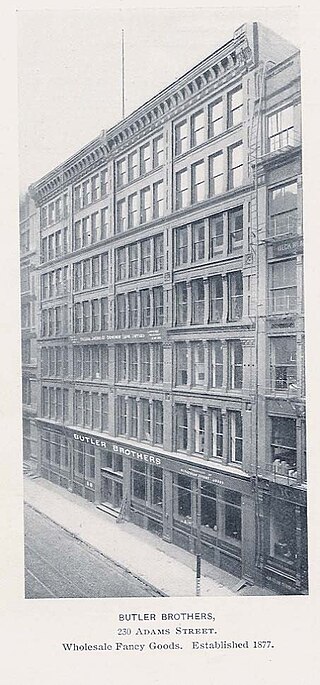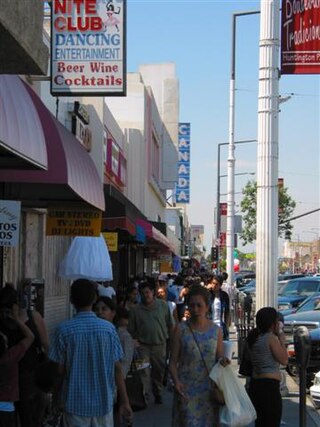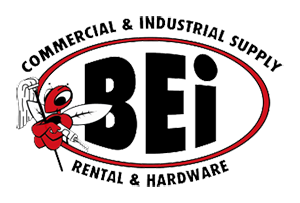
Pacoima is a neighborhood in Los Angeles, California. Pacoima is one of the oldest neighborhoods in the San Fernando Valley region of LA.
Gemco was an American chain of membership department stores that was owned by San Leandro-based Lucky Stores, a California supermarket company which eventually became part of Albertsons. Gemco operated from 1959 until closing in late 1986. A number of the west coast stores leases were sold to Target which fueled their entry into California. Gemco had a version called Memco, also owned by Lucky Stores, that operated stores in the Chicago, Illinois, and Washington, D.C., areas.

Butler Brothers was a retailer and wholesale supplier based in Chicago. It was founded in 1877 as a mail-order company by Charles Hamblet Butler, George H. Butler and Edward Burgess Butler.

White Front was a chain of discount department stores in California and the western United States from 1959 through the mid-1970s. The stores were noted for the architecture of their store fronts which was an enormous, sweeping archway with the store name spelled in individual letters fanned across the top.

FedMart was a chain of discount department stores started by Sol Price, who later founded Price Club. Originally a discount department store open to government employees paying a $2 per family membership fee, FedMart earned four times more than its investors had projected in its first year. Over the next 20 years, FedMart grew to include 45 stores, mostly in California, and the Southwest in a chain that generated over $300 million in annual sales. The business expanded to several states in the Southwest United States. Many stores were previous White Front or Two Guys locations. Price later sold two-thirds of the chain to Hugo Mann, a German retail chain, in 1975 and was forced out of his leadership position the following year. FedMart went out of business in 1982.

Federal Employees' Distributing Company, known as Fedco, was a membership department store chain that operated in Southern California from 1948 to 1999.

Heilig-Meyers was a retail furniture store chain founded in Goldsboro, North Carolina, in 1913 by two Lithuanian immigrants, W. A. Heilig and J. M. Meyers. Its corporate headquarters was in Richmond, Virginia. The chain grew to become the largest furniture retailer in the United States in the 1990s, ultimately having over 1,000 stores nationwide.

Pacific Boulevard is a street and principal commercial thoroughfare in the city of Huntington Park, California and the Los Angeles County neighborhood of Walnut Park. It runs from Vernon and Santa Fe Avenues in Vernon to Cudahy Street in Walnut Park before changing to Long Beach Boulevard. The Pacific Boulevard commercial district is the third highest grossing commercial district in the County of Los Angeles. The Christmas Lane Parade, seen in millions of homes via television throughout the United States and parts of Europe, has run down Pacific Boulevard since 1946. As many as 300,000 people attend the annual Carnaval Primavera held on Pacific Boulevard each year. Pacific Boulevard is well known to Latino residents of the L.A. area, and a magnet for commerce, culture, and night life.
Curacao, formerly La Curacao, is a large-format retail store chain and finance company with export, travel and money transfer services. Founded in 1978, Curacao is headquartered in Los Angeles with retail locations in California, Arizona and Nevada.

Builders Emporium was a chain of home improvement stores based in Irvine, California, United States. At the time of its closing in 1993, it had 82 stores in Southern California and an additional 15 in Nevada, New Mexico, Arizona and Texas; 4,300 employees in total.
Akron Stores or The Akron was a Southern California–based imported goods and home decorating department store retail chain established in 1947 and was known to carry unusual merchandise, mostly imports. The chain had over 24 stores throughout Southern California from San Diego to San Francisco before it was forced to close in 1985.
Z Gallerie is an American chain of home furnishing, art and decor retail stores founded by siblings Joe Zeiden, Mike Zeiden, and Carole Malfatti in Sherman Oaks, California in 1979. The operation began as a small poster shop and started opening combined retail locations in 1982. The retailer was acquired by Brentwood Associates Private Equity V LP in 2014. Karat Home Inc. acquired Z Gallerie on Jan 19, 2024.

Harris & Frank was a clothing retailer and major chain in the history of retail in Southern California, which at its peak had around 40 stores across Southern California and in neighboring states and regions. Its history dates back to a clothing store founded by Leopold Harris in Los Angeles in 1856 near the city's central plaza, only eight years after the city had passed from Mexican to American control. Herman W. Frank joined Harris in partnership 32 years later in 1888.
Nahas was a chain of department stores owned by A. S. Nahas, operating in Greater Los Angeles, carrying clothing, household goods and electronics. They also acquired Rathbun's department store at 5311 Lankershim Boulevard in North Hollywood and cobranded it "Nahas Rathbuns" before the branch closed in 1980. The remaining Nahas stores were closed from 1981 to 1982.

Barker Bros. was a retailer of furniture, home furnishings, and housewares based in Los Angeles, California, United States. Founded as Barker and Mueller in 1880, the business operated under various names through 1992.

7th Street is a street in Los Angeles, California running from S. Norton Ave in Mid-Wilshire through Downtown Los Angeles. It goes all the way to the eastern city limits at Indiana Ave., and the border between Boyle Heights, Los Angeles and East Los Angeles.
Adray's was the name of two appliance and electronics retailers, one a single store and the other a chain of stores, both based in Southern California. The independent store at 1809 W. Chapman Avenue in the City of Orange had been fully owned by Lou Adray since 1971 when he bought out its founders, his brother Andy and their cousin Eddie Aladray. This store was described by the Los Angeles Times at its closure in 1998 as an "institution". The separate store chain, also branded Adray's but incorporated as Adry-Mart Inc., was run by Lou Adray's relatives and operated up to 10 stores in Los Angeles and Ventura Counties.
The El Monte Shopping Center was a major shopping center, for decades the largest shopping center in El Monte, California, at 400 Peck Road just north of the San Bernardino Freeway. It opened in phases in 1958 and 1959 and was initially anchored by a 263,951-square-foot (24,521.9 m2) Sears plus its 20,000-square-foot (1,900 m2) automotive center as well as a 39,000-square-foot (3,600 m2) Food Giant supermarket, a F. W. Woolworth five and dime, and a Bond's clothing store.

Retail in Southern California dates back to its first dry goods store that Jonathan Temple opened in 1827 on Calle Principal, when Los Angeles was still a Mexican village. After the American conquest, as the pueblo grew into a small town surpassing 4,000 population in 1860, dry goods stores continued to open, including the forerunners of what would be local chains. Larger retailers moved progressively further south to the 1880s-1890s Central Business District, which was later razed to become the Civic Center. Starting in the mid-1890s, major stores moved ever southward, first onto Broadway around 3rd, then starting in 1905 to Broadway between 4th and 9th, then starting in 1915 westward onto West Seventh Street up to Figueroa. For half a century Broadway and Seventh streets together formed one of America's largest and busiest downtown shopping districts.
The Butler Brothers Department Stores were a chain of department stores that opened in the 1950s.










